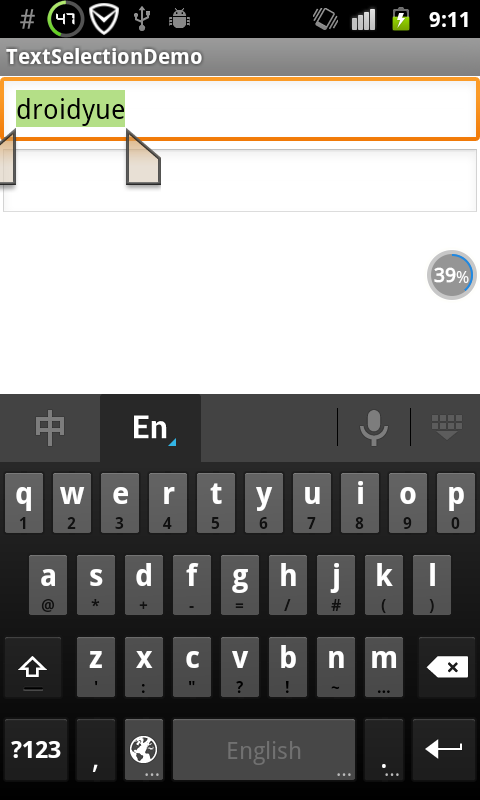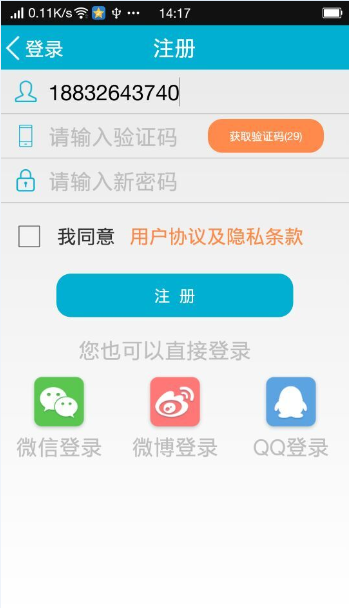1、Service的種類 按運行地點分類:
類別
區別
優點
缺點
應用
本地服務(Local)
該服務依附在主進程上,
服務依附在主進程上而不是獨立的進程,這樣在一定程度上節約了資源,另外Local服務因為是在同一進程因此不需要IPC,也不需要AIDL。相應bindService會方便很多。
主進程被Kill後,服務便會終止。
非常常見的應用如:HTC的音樂播放服務,天天動聽音樂播放服務。
遠程服務(Remote)
該服務是獨立的進程,
服務為獨立的進程,對應進程名格式為所在包名加上你指定的android:process字符串。由於是獨立的進程,因此在Activity所在進程被Kill的時候,該服務依然在運行,不受其他進程影響,有利於為多個進程提供服務具有較高的靈活性。
該服務是獨立的進程,會占用一定資源,並且使用AIDL進行IPC稍微麻煩一點。
一些提供系統服務的Service,這種Service是常駐的。
其實remote服務還是很少見的,並且一般都是系統服務。
按運行類型分類:
類別
區別
應用
前台服務
會在通知一欄顯示 ONGOING 的 Notification,
當服務被終止的時候,通知一欄的 Notification 也會消失,這樣對於用戶有一定的通知作用。常見的如音樂播放服務。
後台服務
默認的服務即為後台服務,即不會在通知一欄顯示 ONGOING 的 Notification。
當服務被終止的時候,用戶是看不到效果的。某些不需要運行或終止提示的服務,如天氣更新,日期同步,郵件同步等。
有同學可能會問,後台服務我們可以自己創建 ONGOING 的 Notification 這樣就成為前台服務嗎?答案是否定的,前台服務是在做了上述工作之後需要調用 startForeground ( android 2.0 及其以後版本 )或 setForeground (android 2.0 以前的版本)使服務成為 前台服務。這樣做的好處在於,當服務被外部強制終止掉的時候,ONGOING 的 Notification 任然會移除掉。
按使用方式分類:
類別
區別
startService 啟動的服務
主要用於啟動一個服務執行後台任務,不進行通信。停止服務使用stopService
bindService 啟動的服務
該方法啟動的服務要進行通信。停止服務使用unbindService
startService 同時也 bindService 啟動的服務
停止服務應同時使用stepService與unbindService
以上面三種方式啟動的服務其生命周期也有區別,將在隨後給出。
2、Service 與 Thread 的區別 很多時候,你可能會問,為什麼要用 Service,而不用 Thread 呢,因為用 Thread 是很方便的,比起 Service 也方便多了,下面我詳細的來解釋一下。
1). Thread:Thread 是程序執行的最小單元,它是分配CPU的基本單位。可以用 Thread 來執行一些異步的操作。
2). Service:Service 是android的一種機制,當它運行的時候如果是Local Service,那麼對應的 Service 是運行在主進程的 main 線程上的。如:onCreate,onStart 這些函數在被系統調用的時候都是在主進程的 main 線程上運行的。如果是Remote Service,那麼對應的 Service 則是運行在獨立進程的 main 線程上。因此請不要把 Service 理解成線程,它跟線程半毛錢的關系都沒有!
既然這樣,那麼我們為什麼要用 Service 呢?其實這跟 android 的系統機制有關,我們先拿 Thread 來說。Thread 的運行是獨立於 Activity 的,也就是說當一個 Activity 被 finish 之後,如果你沒有主動停止 Thread 或者 Thread 裡的 run 方法沒有執行完畢的話,Thread 也會一直執行。因此這裡會出現一個問題:當 Activity 被 finish 之後,你不再持有該 Thread 的引用。另一方面,你沒有辦法在不同的 Activity 中對同一 Thread 進行控制。
舉個例子:如果你的 Thread 需要不停地隔一段時間就要連接服務器做某種同步的話,該 Thread 需要在 Activity 沒有start的時候也在運行。這個時候當你 start 一個 Activity 就沒有辦法在該 Activity 裡面控制之前創建的 Thread。因此你便需要創建並啟動一個 Service ,在 Service 裡面創建、運行並控制該 Thread,這樣便解決了該問題(因為任何 Activity 都可以控制同一 Service,而系統也只會創建一個對應 Service 的實例)。
因此你可以把 Service 想象成一種消息服務,而你可以在任何有 Context 的地方調用 Context.startService、Context.stopService、Context.bindService,Context.unbindService,來控制它,你也可以在 Service 裡注冊 BroadcastReceiver,在其他地方通過發送 broadcast 來控制它,當然這些都是 Thread 做不到的。
3、Service的生命周期 onCreate onStart onDestroy onBind
1). 被啟動的服務的生命周期:如果一個Service被某個Activity 調用 Context.startService 方法啟動,那麼不管是否有Activity使用bindService綁定或unbindService解除綁定到該Service,該Service都在後台運行。如果一個Service被startService 方法多次啟動,那麼onCreate方法只會調用一次,onStart將會被調用多次(對應調用startService的次數),並且系統只會創建Service的一個實例(因此你應該知道只需要一次stopService調用)。該Service將會一直在後台運行,而不管對應程序的Activity是否在運行,直到被調用stopService,或自身的stopSelf方法。當然如果系統資源不足,android系統也可能結束服務。
2). 被綁定的服務的生命周期:如果一個Service被某個Activity 調用 Context.bindService 方法綁定啟動,不管調用 bindService 調用幾次,onCreate方法都只會調用一次,同時onStart方法始終不會被調用。當連接建立之後,Service將會一直運行,除非調用Context.unbindService 斷開連接或者之前調用bindService 的 Context 不存在了(如Activity被finish的時候),系統將會自動停止Service,對應onDestroy將被調用。
3). 被啟動又被綁定的服務的生命周期:如果一個Service又被啟動又被綁定,則該Service將會一直在後台運行。並且不管如何調用,onCreate始終只會調用一次,對應startService調用多少次,Service的onStart便會調用多少次。調用unbindService將不會停止Service,而必須調用 stopService 或 Service的 stopSelf 來停止服務。
4). 當服務被停止時清除服務:當一個Service被終止(1、調用stopService;2、調用stopSelf;3、不再有綁定的連接(沒有被啟動))時,onDestroy方法將會被調用,在這裡你應當做一些清除工作,如停止在Service中創建並運行的線程。
特別注意:
1、你應當知道在調用 bindService 綁定到Service的時候,你就應當保證在某處調用 unbindService 解除綁定(盡管 Activity 被 finish 的時候綁定會自 動解除,並且Service會自動停止);
2、你應當注意 使用 startService 啟動服務之後,一定要使用 stopService停止服務,不管你是否使用bindService;
3、同時使用 startService 與 bindService 要注意到,Service 的終止,需要unbindService與stopService同時調用,才能終止 Service,不管 startService 與 bindService 的調用順序,如果先調用 unbindService 此時服務不會自動終止,再調用 stopService 之後服務才會停止,如果先調用 stopService 此時服務也不會終止,而再調用 unbindService 或者 之前調用 bindService 的 Context 不存在了(如Activity 被 finish 的時候)之後服務才會自動停止;
4、當在旋轉手機屏幕的時候,當手機屏幕在“橫”“豎”變換時,此時如果你的 Activity 如果會自動旋轉的話,旋轉其實是 Activity 的重新創建,因此旋轉之前的使用 bindService 建立的連接便會斷開(Context 不存在了),對應服務的生命周期與上述相同。
5、在 sdk 2.0 及其以後的版本中,對應的 onStart 已經被否決變為了 onStartCommand,不過之前的 onStart 任然有效。這意味著,如果你開發的應用程序用的 sdk 為 2.0 及其以後的版本,那麼你應當使用 onStartCommand 而不是 onStart。
4、startService 啟動服務 想要用 startService 啟動服務,不管Local 還是 Remote 我們需要做的工作都是一樣簡單。當然要記得在 Androidmanifest.xml 中注冊 service。
根據上面的生命周期,我們便會給出 Service 中的代碼框架:
代碼如下:
package com.newcj.test;
import android.app.Service;
import android.content.Intent;
import android.os.IBinder;
public class LocalService1 extends Service {
/**
* onBind 是 Service 的虛方法,因此我們不得不實現它。
* 返回 null,表示客服端不能建立到此服務的連接。
*/
@Override
public IBinder onBind(Intent intent) {
return null;
}
@Override
public void onCreate() {
super.onCreate();
}
@Override
public void onStart(Intent intent, int startId) {
super.onStart(intent, startId);
}
@Override
public void onDestroy() {
super.onDestroy();
}
}
代碼如下:
// 啟動一個 Activity
startActivity(new Intent(this, LocalService1.class));
...
// 停止一個 Activity
stopService(new Intent(this, LocalService1.class));
對應的 Intent 為標志服務類的 Intent。
5、Local 與 Remote 服務綁定 同樣記得在 Androidmanifest.xml 中注冊 service
1). Local 服務綁定:Local 服務的綁定較簡單,首先在 Service 中我們需要實現 Service 的抽象方法 onBind,並返回一個實現 IBinder 接口的對象。
Service 中的代碼:
代碼如下:
package com.newcj.test;
import android.app.Service;
import android.content.Intent;
import android.os.Binder;
import android.os.IBinder;
public class LocalService extends Service {
/**
* 在 Local Service 中我們直接繼承 Binder 而不是 IBinder,因為 Binder 實現了 IBinder 接口,這樣我們可以少做很多工作。
* @author newcj
*/
public class SimpleBinder extends Binder{
/**
* 獲取 Service 實例
* @return
*/
public LocalService getService(){
return LocalService.this;
}
public int add(int a, int b){
return a + b;
}
}
public SimpleBinder sBinder;
@Override
public void onCreate() {
super.onCreate();
// 創建 SimpleBinder
sBinder = new SimpleBinder();
}
@Override
public IBinder onBind(Intent intent) {
// 返回 SimpleBinder 對象
return sBinder;
}
}
上面的代碼關鍵之處,在於 onBind(Intent) 這個方法 返回了一個實現了 IBinder 接口的對象,這個對象將用於綁定Service 的 Activity 與 Local Service 通信。下面是 Activity 中的代碼:
代碼如下:
package com.newcj.test;
import android.app.Activity;
import android.content.ComponentName;
import android.content.Context;
import android.content.Intent;
import android.content.ServiceConnection;
import android.os.Bundle;
import android.os.IBinder;
import android.util.Log;
import android.view.View;
import android.view.View.OnClickListener;
public class Main extends Activity {
private final static String TAG = "SERVICE_TEST";
private ServiceConnection sc;
private boolean isBind;
@Override
public void onCreate(Bundle savedInstanceState) {
super.onCreate(savedInstanceState);
setContentView(R.layout.main);
sc = new ServiceConnection() {
@Override
public void onServiceDisconnected(ComponentName name) {
}
@Override
public void onServiceConnected(ComponentName name, IBinder service) {
LocalService.SimpleBinder sBinder = (LocalService.SimpleBinder)service;
Log.v(TAG, "3 + 5 = " + sBinder.add(3, 5));
Log.v(TAG, sBinder.getService().toString());
}
};
findViewById(R.id.btnBind).setOnClickListener(new OnClickListener() {
@Override
public void onClick(View v) {
bindService(new Intent(Main.this, LocalService.class), sc, Context.BIND_AUTO_CREATE);
isBind = true;
}
});
findViewById(R.id.btnUnbind).setOnClickListener(new OnClickListener() {
@Override
public void onClick(View v) {
if(isBind){
unbindService(sc);
isBind = false;
}
}
});
}
}
在 Activity 中,我們通過 ServiceConnection 接口來取得建立連接 與 連接意外丟失的回調。bindService有三個參數,第一個是用於區分 Service 的Intent 與 startService 中的 Intent 一致,第二個是實現了 ServiceConnection 接口的對象,最後一個是 flag 標志位。有兩個flag,BIND_DEBUG_UNBIND 與 BIND_AUTO_CREATE,前者用於調試(詳細內容可以查看javadoc 上面描述的很清楚),後者默認使用。unbindService 解除綁定,參數則為之前創建的 ServiceConnection 接口對象。另外,多次調用 unbindService 來釋放相同的連接會拋出異常,因此我創建了一個 boolean 變量來判斷是否 unbindService 已經被調用過。
運行結果:

2). Remote 服務綁定:Remote 的服務綁定由於服務是在另外一個進程,因此需要用到 android 的 IPC 機制。這將又是一個很長的話題,因此,我打算寫另外一篇 android 的 IPC 機制分析 ,並在其中進行詳述,然後在這裡更新鏈接,敬請關注。
特別注意:
1、Service.onBind如果返回null,則調用 bindService 會啟動 Service,但不會連接上 Service,因此 ServiceConnection.onServiceConnected 不會被調用,但你任然需要使用 unbindService 函數斷開它,這樣 Service 才會停止。
6、創建前台服務 前台服務的優點上面已經說明,但設置服務為前台服務,我們需要注意在 sdk 2.0 及其以後版本使用的方法是 startForeground 與 stopForeground,之前版本使用的是 setForeground ,因此如果你應用程序的最低運行環境要求是 2.0,那麼這裡可以直接運用新方法,如果運行環境是2.0以下,那麼為了保證向後兼容性,這裡必須使用反射技術來調用新方法。
下面是我仿照 ApiDemos 重新敲的代碼,對某些地方進行了修改,因此更具有說明性:
代碼如下:
package com.newcj.test;
import java.lang.reflect.InvocationTargetException;
import java.lang.reflect.Method;
import android.app.Notification;
import android.app.NotificationManager;
import android.app.PendingIntent;
import android.app.Service;
import android.content.Context;
import android.content.Intent;
import android.os.IBinder;
public class ForegroundService extends Service {
private static final Class[] mStartForegroundSignature = new Class[] {
int.class, Notification.class};
private static final Class[] mStopForegroundSignature = new Class[] {
boolean.class};
private NotificationManager mNM;
private Method mStartForeground;
private Method mStopForeground;
private Object[] mStartForegroundArgs = new Object[2];
private Object[] mStopForegroundArgs = new Object[1];
@Override
public IBinder onBind(Intent intent) {
return null;
}
@Override
public void onCreate() {
super.onCreate();
mNM = (NotificationManager)getSystemService(Context.NOTIFICATION_SERVICE);
try {
mStartForeground = ForegroundService.class.getMethod("startForeground", mStartForegroundSignature);
mStopForeground = ForegroundService.class.getMethod("stopForeground", mStopForegroundSignature);
} catch (NoSuchMethodException e) {
mStartForeground = mStopForeground = null;
}
// 我們並不需要為 notification.flags 設置 FLAG_ONGOING_EVENT,因為
// 前台服務的 notification.flags 總是默認包含了那個標志位
Notification notification = new Notification(R.drawable.icon, "Foreground Service Started.",
System.currentTimeMillis());
PendingIntent contentIntent = PendingIntent.getActivity(this, 0,
new Intent(this, Main.class), 0);
notification.setLatestEventInfo(this, "Foreground Service",
"Foreground Service Started.", contentIntent);
// 注意使用 startForeground ,id 為 0 將不會顯示 notification
startForegroundCompat(1, notification);
}
@Override
public void onDestroy() {
super.onDestroy();
stopForegroundCompat(1);
}
// 以兼容性方式開始前台服務
private void startForegroundCompat(int id, Notification n){
if(mStartForeground != null){
mStartForegroundArgs[0] = id;
mStartForegroundArgs[1] = n;
try {
mStartForeground.invoke(this, mStartForegroundArgs);
} catch (IllegalArgumentException e) {
e.printStackTrace();
} catch (IllegalAccessException e) {
e.printStackTrace();
} catch (InvocationTargetException e) {
e.printStackTrace();
}
return;
}
setForeground(true);
mNM.notify(id, n);
}
// 以兼容性方式停止前台服務
private void stopForegroundCompat(int id){
if(mStopForeground != null){
mStopForegroundArgs[0] = Boolean.TRUE;
try {
mStopForeground.invoke(this, mStopForegroundArgs);
} catch (IllegalArgumentException e) {
e.printStackTrace();
} catch (IllegalAccessException e) {
e.printStackTrace();
} catch (InvocationTargetException e) {
e.printStackTrace();
}
return;
}
// 在 setForeground 之前調用 cancel,因為我們有可能在取消前台服務之後
// 的那一瞬間被kill掉。這個時候 notification 便永遠不會從通知一欄移除
mNM.cancel(id);
setForeground(false);
}
}
特別注意: 1、使用 startForeground ,如果 id 為 0 ,那麼 notification 將不會顯示。
7、在什麼情況下使用 startService 或 bindService 或 同時使用startService 和 bindService
如果你只是想要啟動一個後台服務長期進行某項任務那麼使用 startService 便可以了。如果你想要與正在運行的 Service 取得聯系,那麼有兩種方法,一種是使用 broadcast ,另外是使用 bindService ,前者的缺點是如果交流較為頻繁,容易造成性能上的問題,並且 BroadcastReceiver 本身執行代碼的時間是很短的(也許執行到一半,後面的代碼便不會執行),而後者則沒有這些問題,因此我們肯定選擇使用 bindService(這個時候你便同時在使用 startService 和 bindService 了,這在 Activity 中更新 Service 的某些運行狀態是相當有用的)。另外如果你的服務只是公開一個遠程接口,供連接上的客服端(android 的 Service 是C/S架構)遠程調用執行方法。這個時候你可以不讓服務一開始就運行,而只用 bindService ,這樣在第一次 bindService 的時候才會創建服務的實例運行它,這會節約很多系統資源,特別是如果你的服務是Remote Service,那麼該效果會越明顯(當然在 Service 創建的時候會花去一定時間,你應當注意到這點)。
8、在 AndroidManifest.xml 裡 Service 元素的常見選項 android:name ------------- 服務類名
android:label -------------- 服務的名字,如果此項不設置,那麼默認顯示的服務名則為類名
android:icon -------------- 服務的圖標
android:permission ------- 申明此服務的權限,這意味著只有提供了該權限的應用才能控制或連接此服務
android:process ---------- 表示該服務是否運行在另外一個進程,如果設置了此項,那麼將會在包名後面加上這段字符串表示另一進程的名字
android:enabled ---------- 如果此項設置為 true,那麼 Service 將會默認被系統啟動,不設置默認此項為 false
android:exported --------- 表示該服務是否能夠被其他應用程序所控制或連接,不設置默認此項為 false

 Android中EditText和AutoCompleteTextView設置文字選中顏色方法
Android中EditText和AutoCompleteTextView設置文字選中顏色方法
 Android JSON解析器
Android JSON解析器
 Android手機獲取驗證碼的實例解析
Android手機獲取驗證碼的實例解析
 Android JSON解析器
Android JSON解析器